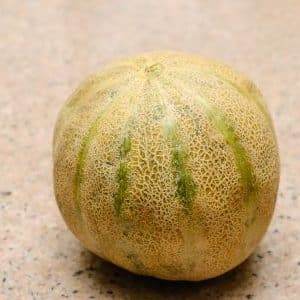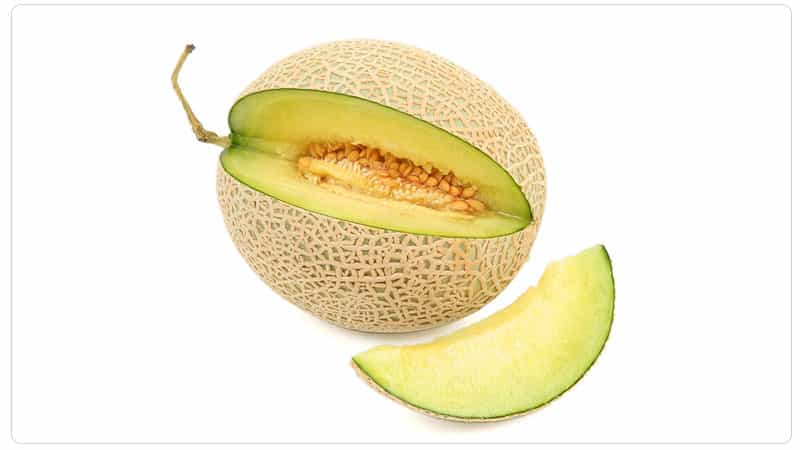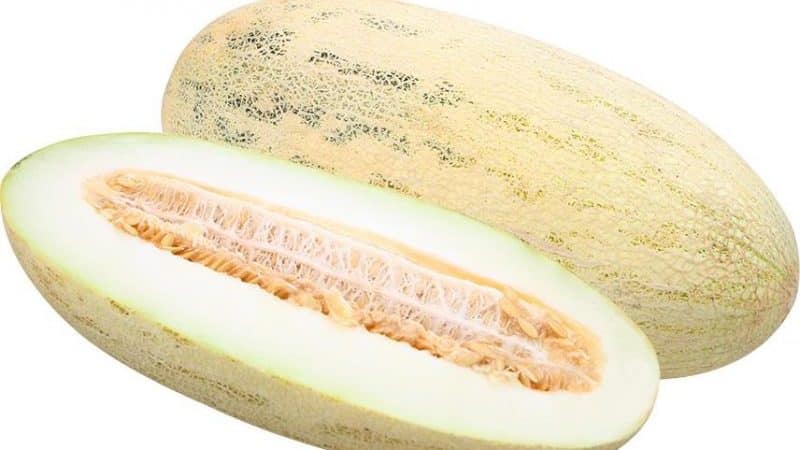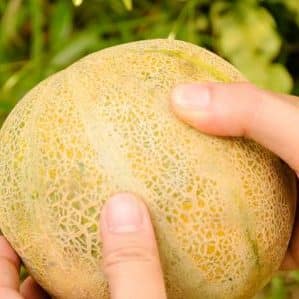What to do if the melon is not ripe: storage rules for fruit ripening and tips for choosing
Melon is a juicy, aromatic and healthy dessert. It cleanses the intestines, removes waste and toxins. Another of its advantages is its rejuvenating effect. The composition of melons includes: potassium, magnesium, iron, phosphorus, vitamins C, A, group B. But most importantly, this sweet fruit can be consumed without harm to the figure - its calorie content is only 38 kcal per 100 g of product.
But how to choose a fragrant and sweet melon so that it gives pleasure and brings maximum benefits? And what should you do if the purchased fruit turns out to be slightly under-ripe? Read on to learn how to choose the right ripe melon and how to ripen melons.
Choosing ripe
There are several signs by which the degree of melon ripeness is determined:
- Aroma. A ripe melon has a sweet and pleasant smell. When choosing it at the market or in a store, pay attention to the aroma first.

- Skin. When you press on the peel, it springs elastically and easily restores its shape; its color should be bright (depending on the variety) with a pattern similar to cracks and cuts.
- Heaviness. The weight of a ripe fruit is significantly greater than that of an unripe one. First, select a green melon and a ripe one of about the same size. Hold both in your hands - everything will become clear.
- Nose and tail. The first should be soft, and the second thick and dry.
- Sound. If you knock on a ripe fruit, it will be deaf.
Note! The skin of an overripe melon will be too soft.If the skin is too hard, the fruit is unripe.
Will it be possible to ripen at home?

Can melon ripen at home? Yes, it ripens not only in the garden. It is enough to place the fruit in a dark, warm or cool (depending on the variety), dry place. Early varieties ripen faster - warmth suits them; late varieties, on the contrary, cool. The optimal temperature for storage is 0 °C.
The shelf life of sweet melons can be long if they were prepared for this in advance: cut at the right time (not green and not quite ripe), heated in the beds. Premises for long-term storage should be dry, dark and cool.
If you bought a melon, and later, upon closer inspection, discovered that the fruit is green, do not be upset. He may well finish it by lying at home. The main condition for successful ripening is not to cut the melon. Once cut, it will not be able to be stored and ripened for a long time.
How long will it lie
A melon picked before its due date (completely green) does not ripen well or remains unripe. At the same time, her taste deteriorates. Gardeners have noticed that fruit covered with a pronounced mesh ripens better.
The storage duration is also affected by the variety. Early varieties are stored for only a week after being removed from the garden. Mid-early and a small number of early varieties can last up to 21 days.
What to do if the melon is not ripe
What to do if the melon is not ripe? It was probably taken from the garden when it was green, and that’s why it doesn’t ripen. Experienced housewives advise not to worry and use the fruits for culinary purposes.. For example, cook jam.
The recipe is simple. The melon is washed, peeled and cut into cubes. Per kilogram of raw materials you will need 1.2 kg of sugar.Half of its volume is poured into the cubes overnight, or for 12 hours, so that the pulp produces juice. Then add the remaining sugar and let it simmer for 8-10 minutes. Then the syrup is left to cool thoroughly (for 7-8 hours) and boiled again until ready. The result is a delicious, aromatic jam.
If you add lemon or orange zest, it will be even tastier. You can also add a cinnamon stick per kilogram of raw material or ginger. The taste is spicy. If you twist the pulp and boil it with added sugar, you get a delicious puree.
Choosing optimal conditions for ripening
It is best to send sweet fruits of late varieties for ripening. During ripening, such varieties acquire sweetness and benefits. But early varieties can also ripen at home, although their taste will deteriorate slightly. For ripening, choose a dark, well-ventilated, warm and dry place.
To make the melon ripen at home, do the following. If after several days ripening does not occur, experienced gardeners advise placing a ripe apple next to it (it speeds up ripening).
If the variety is late, then it ripens longer and needs to sit not for a couple of days, but for two or three weeks, or even a month. What can be done to achieve such fruit? It is better to ripen late varieties in cool, dry and dark rooms so that they do not spoil in the heat.
be careful! It is better for those with diabetes to avoid melon. Ulcer and gastritis – also a reason to reduce the consumption of melons to a minimum. Nursing mothers are not recommended to eat more than one or two pieces, otherwise the baby may experience bowel problems.
We store it until it's ready
Will the green melon make it home? To make it “get there”, use the recommendations of the previous chapter. There are several other features that should be taken into account when storing the product. After picking or purchasing, it is advisable to place the fruits so that they do not come into contact with each other.
This method of ripening has proven to be excellent: hanging melons in a net or bag in a room with appropriate conditions (dark, cool, dry). The tails are not torn off or cut off - rotting may begin in this place.
Rules for choosing ripe delicacies

For long-term storage, only good ones are selected, without dents, cracks, scratches or signs of rotting melons. Damaged skin of the fruit allows pathogenic microflora to penetrate inside. Instead of enjoying exquisite taste, you can end up in a hospital bed.
Before August, you can hardly expect to buy really ripe and tasty fruit. If you purchase it ahead of time, you may end up with a product of dubious quality. We discussed the rules for choosing a fragrant dessert, common to all melons, in the first chapter. But there are some nuances for individual varieties:
- variety Collective farmer should be aromatic: even an uncut melon has a rather strong honey-vanilla or pear smell, its color is bright yellow;
- melon Torpedo They also choose by smell, they also pay attention to the rough “mesh” on the peel - the more grooves, the sweeter the fruit;
- ripe Ethiopian is yellow-orange, the smell is pronounced, with a pineapple note.
It is important to know! It is better not to buy an odorless melon - it is either completely green, or when growing it, they went too far with nitrogen fertilizers.
To avoid disappointment

The first rule that should be followed when buying melons is the correct choice of place of purchase. Supermarkets and specialty markets are fine.Here the conditions for storage are appropriate, since these places are controlled by sanitary authorities.
Do not hesitate to demand a certificate for the product. Conscientious entrepreneurs definitely have it, but it is better to avoid unscrupulous ones. Buying melons from the road side is risky. Fruits kept in such conditions for a long time become saturated with toxins, heavy metals, and are stored without observing sanitary standards, which will inevitably affect the taste and usefulness of the product.
It’s also not worth purchasing cut fruit - it is unknown how long it spent on the counter in this form.
In the table we will look at the signs that it is better to refuse the purchase if you find them.
| Sign | What's the downside? | Why is it better not to use |
| The skin is shiny and leaves a greasy mark on your hands. | The fruit was grown using waxes that protected the melon from spoilage. | The benefits of waxes for the body are very questionable, and the taste of the product deteriorates. |
| Excessively dirty peel. | Most likely the harvest took place in the rain. | The taste of this fruit is unimportant, the flesh is watery. |
| Peel too clean. | Before reaching the counter, the melon was washed. | Fruit washed before transportation or sale looks beautiful, but such a procedure deprives it of natural bactericidal protection. |
| Brown spots on the peel. | Such spots are the first sign of rotting. | Rotten foods are of little use, and there is a chance of getting poisoned or infected.
|
Is unripe fruit harmful?

The maximum amount of nutrients is concentrated in the ripe product. Therefore, an unripe or overripe delicacy will not bring any benefit. In addition, eating green fruit can cause digestive problems.Especially if a person has gastrointestinal diseases, such as gastritis, stomach ulcers. In this category of people, unripe fruits can provoke an exacerbation of the disease.
Even healthy people may experience bloating or upset bowel movements.
On Internet forums, melon lovers quite often mention dishes made from unripe melons. Melon jam, candied fruits or pickled melons are especially popular. We advise you to treat such recipes with caution.
On a note. In order for the melon to bring maximum benefit and not cause harm, you need to follow some rules. It is better to eat it not on an empty stomach, but between meals. It is not recommended to drink water. It is not advisable to eat dairy or fermented milk products after or before melon - you may get an upset stomach.
Conclusion
Melon is a fragrant, low-calorie, healthy dessert. In order for it to bring pleasure and maximum benefit, you need to be able to choose it and use it correctly. If you made a mistake in your choice or bought a delicacy for future use, the unripe fruit can easily end up at home. Now you know how to preserve it and help it finish.
Before use, it is necessary to take into account the presence of diseases that can cause harm to melon. Pregnant and nursing mothers, and allergy sufferers also need to be careful with the aromatic dessert. But healthy people can enjoy it to their heart's content.